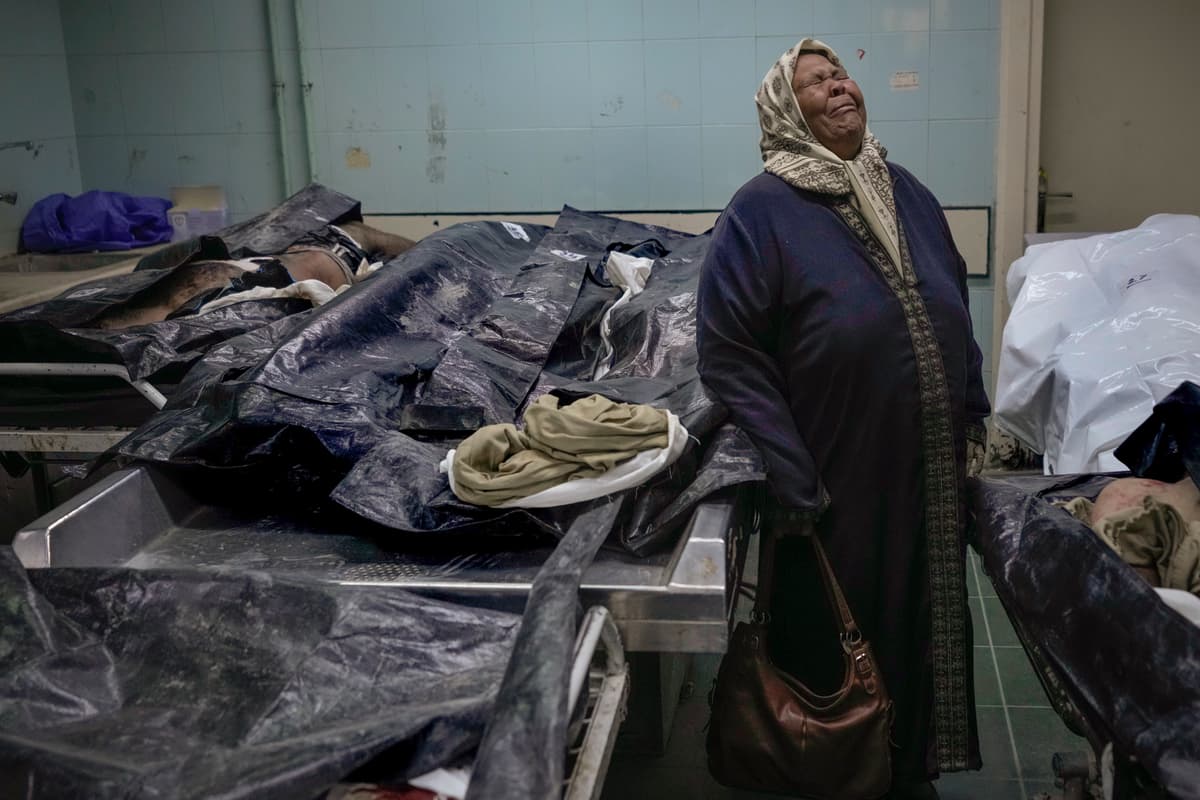Who Will Govern Syria Is the Emerging Question in the Post-Assad Power Struggle
As the initial euphoria fades, uncomfortable questions about the country’s future are arising.

As Syria emerges from more than five decades of Assad family rule, the pressing question is who can be trusted to govern the fractured, war-torn nation. Few anticipated the events in Damascus this past week, with Hayat Tahrir al-Sham, the leading rebel group, taking control. As the initial euphoria fades, uncomfortable questions about the country’s future are arising.
“Syrian people are against Islamist reign. All my friends refuse the Al Qaeda flag next to the Syrian flag. We want a civic country; we want to live in a peaceful society, not a fanatical one,” one 30-something Damascus professional, who requested anonymity out of fear of upsetting rebel groups, tells The New York Sun via encrypted messenger. “Is this an occupation? Many Syrians are starting to worry.”
Hayat Tahrir al-Sham, after all, is a former affiliate of Al Qaeda. It has captured the spotlight, but the Syrian opposition is not a singular force. Multiple players and rivalries are in the mix. Syria observers largely agree that many of these disparate factions came together, leading to the military triumph, but lasting unity is far from guaranteed.
“The current situation in Syria introduces several destabilizing risks that could affect not just Syria but the entire region,” Chief Operations Officer for the Middle East Forum, Gregg Roman, tells the Sun. “The primary concern centers on Syria splintering into competing territories, each supported by different external powers. Such fragmentation might create uncontrolled areas where terrorist organizations like ISIS could rebuild their presence.”
So, who are the power players?
Hayat Tahrir al-Sham
At the forefront of the new caretaker government is Hayat Tahrir al-Sham, whose name means Organization for the Liberation of the Levant. The group distanced itself from al-Qaeda in 2017, pledging to eschew its global jihadist ideology to focus solely on domestic Syrian affairs and displacing tyrant Bashar Al-Assad with an Islamic government. It’s likely to have the most pull given its leading role in the Syrian takeover.
The group — estimated to have 30,000 fighters — is led by Abu Mohammad al-Jolani, a 42-year-old who was born to exiled Syrian parents in Saudi Arabia. The family is said to have moved back to Syria in the 1980s. In 2003, Mr. Jolani entered neighboring Iraq to fight the Americans on behalf of Al Qaeda, leading to several years behind bars in an American jail.
While Mr. al-Jolani claims Hayat Tahrir al-Sham has moved past its extremist roots and now prioritizes rebuilding Syria, questions remain about the group’s intentions. Hayat Tahrir al-Sham is a designated foreign terrorist organization in the United States, and Mr. Jolani is a wanted terrorist with a $10 million bounty on his head. No decision has been made on whether Washington would relent on this stance.
“Over time, his behavior seems to have changed. When he was in Al Qaeda, he was in his 20s. Transformation happens, especially with age,” the president of the California-based Syrian Institute for Peace, Saed Moujtahed, tells the Sun. “Now, has he definitely changed? Only God knows. But based on his recent conduct, it appears his behavior has evolved. He’s conducting himself in a civilized manner.”
Mr. Moujtahed reckons that the “message” that Mr. al-Jaloni has s been sending is one of unity. He’s trying to reassure minorities like Christians, emphasizing that they’re part of the same family and that there’s no intention for revenge.” Mr. Moujtahed pointed out that Mr. Jolani is now purporting to use his real name, Ahmad Hussein al-Shar’A, to come across as more moderate and personable.
The Broader Opposition
The Syrian National Army, unlike the centralized Hayat Tahrir al-Sham, is a fragmented coalition of armed groups, some of which originated from the Free Syrian Army and often clash internally. While many factions, like the Sultan Suleiman Shah Brigade and the Sultan Murad Brigade, are closely aligned with Turkey, others, such as Ahrar al-Sham, pursue their own priorities, including establishing Sharia governance.
Over a decade ago, Washington tried its hand at supporting Syrian opposition groups but soon realized it was a maze with divergent interests. In 2014, President Obama and Prime Minister Erdoğan agreed to train and equip so-called moderate Syrian opposition forces to fight both the Assad regime and Islamic State.
After $500 million in funding, however, failed to yield results, Washington withdrew support, straining relations with Ankara. One rebel commander, Zayd, who was trained and equipped by the Pentagon, admitted to this reporter several years after the fact that he brokered a deal with Syria’s Al Qaeda affiliate, Al Nusra. In order to leave the United States-mandated post to fight the Islamic State and return to his home and instead focus on battling Assad fighters, he had to go through territory occupied by Al Nusra. In exchange for safe passage, Zayd said that he gave the terrorist organization the trucks and ammunition issued to him by the Americans.
He also explained that fighters whom the Defense Department was paying a $250 monthly salary began defecting to other groups, leading to American weapons being diverted to Al Nusra and the black market.
Who can and can’t be relied upon is a protracted headache for decision-makers. “The risk is that these groups, which came together to take advantage of the weakening of Iran and Hezbollah and toppled the Assad regime, could engage in a power struggle to forge a post-Assad political order,” the senior director for Eurasian security and prosperity at New Lines Institute for Strategy and Policy in Washington, Kamran Bokhari, tells the Sun.
“Assuming — a big if — that they can agree on a power-sharing settlement, the big question is how these Sunni Arab, largely Islamist, factions will behave toward the country’s non-Sunni Arab minorities and, more importantly, the Kurds, who have enjoyed self-rule for a decade in the country’s northeast and east.”
The United States in 2015 instead turned to the Kurdish People’s Protection Units, rebranded as the Syrian Democratic Forces to include Arabs and other groups. This did little to alter Turkey’s position, which continues to view them as an extension of the Kurdish separatist threat. The question of whether there can be a Syria where all groups, interests, and ethnicities can freely vote and secure adequate representation highlights the complexities that arise.
The Governance Plan
Outgoing Syrian Prime Minister Mohammed al-Jalili announced that most of his former cabinet is cooperating with rebels to ensure a smooth transition of power. Mr. Jolani met with al-Jalili, who agreed to transfer authority to Hayat Tahrir al-Sham’s Syrian Salvation Government, led by one of the group’s political authorities, Mohammed al-Bashir. The transitional government aims to consolidate control, reform institutions, and address the displacement crisis.
Yet Syria is unlikely to be free from outside influences and expectations. Turkey has emerged as a key beneficiary of Mr. Assad’s removal. Despite officially declaring Hayat Tahrir al-Sham a terrorist group in 2018, Ankara has long backed the group quietly and offered more public support for the Syrian National Army. There will be an expectation of compensation.
Turkey’s primary objective in Syria is to squash Kurdish forces, including those working with its North Atlantic Treaty Organization partner, the United States, adding yet another layer of complexity to the mix. While jubilation continues across much of the embattled country, conflict persists in several pockets.
Turkish-backed rebel factions took advantage of the vacuum and launched an offensive on Kurdish-held territories north of Aleppo, where U.S.-supported Syrian Democratic Forces are based. Concurrently, Hayat Tahrir al-Sham and allied forces advanced in western Deir al-Zour while Turkish-backed Syrian National Army fighters pushed into northwest Aleppo.
“Turkish-backed troops attacked Manbij city, and they captured Kurdish people and took their property, and have advanced toward Kobane,” one Syrian-Kurdish civilian, who did not want to be named, tells the Sun via encrypted messenger. “We don’t know what will happen, but we are in fear because they are not like HTS behavior in other areas. The goal of these groups is to remove the Kurdish from the border of Turkey.”
Mr. Assad largely left Syria’s Kurds in the northeast to govern themselves with semi-autonomy, but it is uncertain whether a new, possibly Islamist-dominated regime will offer them the same freedom, especially with its reliance on Erdoğan. Turkish-backed Islamists have also made territorial gains against the U.S.-backed Syrian Democratic Forces in the eastern Aleppo countryside.
The Kurds’ situation is further complicated by President Trump’s recent statement urging that America stay out of Syria’s conflict despite the U.S. having supported the Syrian Democratic Forces in their fight against the Islamic State. Syria is now divided into four main areas: Turkish-controlled regions in the north, Syrian Democratic Forces-held territories in the northeast, rebel-held Idlib, and areas under Assad’s control in the west. Former Assad loyalists retained control of Syria’s Mediterranean coast and mountainous regions, home to key Russian military bases.
“The interplay between these groups, combined with the interests of external nations like Turkey, Russia, the U.S. and Iran, will shape Syria’s immediate future,” Mr. Roman said. “The possibility of extended internal conflict remains high, especially if no single entity can establish recognized authority over considerable territory.”
The Washington Factor
Whether the United States stands to gain or lose in the fall of Assad and its influence on the next chapter is yet to be determined. With 900 GIs stationed in Syria to help the Syrian Democratic Forces fight the Islamic State, the future of the American presence remains uncertain under the incoming Trump administration, which may prioritize an “America First” approach and pull troops regardless of the situation.
“The United States should substantially increase its military footprint in Syria to approximately 5,000 troops, focusing on three critical objectives: securing the Iraqi-Syrian border, preventing ISIS resurgence, and supporting our Kurdish allies who have proven themselves reliable partners in maintaining regional stability,” Mr. Roman said. “Recent developments make this expansion not just advisable but necessary. A more robust American presence would provide several strategic advantages.
Not everyone agrees.
“The United States should steer clear of increasing its military footprint in the country given that our troops could find themselves in the complex and multi-layered set of fault lines within the country,” contended Mr. Bokhari. “Instead, it should adopt a balance of power strategy by working with regional allies: Turkey, Israel, Saudi Arabia, UAE, and Jordan.”

